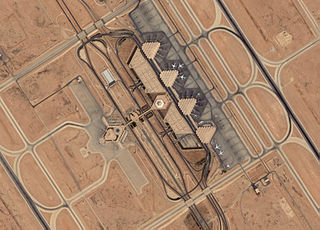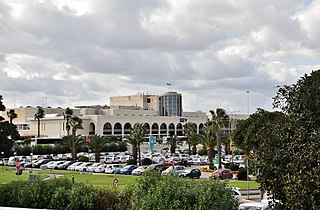
Saudia, formerly known as Saudi Arabian Airlines, is the flag carrier of Saudi Arabia, based in Jeddah. The airline's main hubs are the King Abdulaziz International Airport in Jeddah and the King Khalid International Airport in Riyadh, the latter of which it plans to move out of by 2030.

Frankfurt Airport, is Germany's main international airport by passenger numbers, located in Frankfurt, Germany's fifth-largest city. In the German Aeronautical Information Publication, its name is Frankfurt Main Airport. The airport is operated by Fraport and serves as the main hub for Lufthansa, including Lufthansa CityLine and Lufthansa Cargo as well as Condor and AeroLogic. It covers an area of 2,300 hectares of land and features two passenger terminals with capacity for approximately 65 million passengers per year; four runways; and extensive logistics and maintenance facilities.

Kuwait International Airport is an international airport located in the Farwaniya Governorate, Kuwait, 15.5 kilometers (9.6 mi) south of the centre of Kuwait City, spread over an area of 37.7 square kilometres (14.6 sq mi). It serves as the primary hub for Kuwait Airways and Jazeera Airways. A portion of the airport complex is designated as Abdullah Al-Mubarak Air Base, which contains the headquarters of the Kuwait Air Force, as well as the Kuwait Air Force Museum.

King Khalid International Airport is an international airport located about 35 kilometres (22 mi) north of Riyadh, Saudi Arabia, designed by the architectural firm HOK, and Arabian Bechtel Company Limited served as the construction manager on behalf of the Saudi government.
Zayed International Airport, also known as Abu Dhabi International Airport, is the primary international airport serving Abu Dhabi, the capital of the United Arab Emirates (UAE). It is the second busiest airport in the UAE after Dubai International Airport, one of the busiest airports in the Middle East and is the hub for Etihad Airways as well as an operating base for Wizz Air Abu Dhabi and Air Arabia Abu Dhabi.

Cairo International Airport is the principal international airport of Cairo and the largest and busiest airport in Egypt. It serves as the primary hub for Egyptair and Nile Air as well as several other airlines. The airport is located in Heliopolis, to the northeast of Cairo around fifteen kilometres from the business area of the city and has an area of approximately 37 km2 (14 sq mi). It is the busiest airport in Africa and one of the busiest airports in the Middle East in terms of total passengers.

Addis Ababa Bole International Airport is an international airport in Addis Ababa, Ethiopia. It is in the Bole district, 6 km (3.7 mi) southeast of the city centre and 65 km (40 mi) north of Bishoftu. The airport was formerly known as Haile Selassie I International Airport. It is the main hub of Ethiopian Airlines, the national airline that serves destinations in Ethiopia and throughout the African continent, as well as connections to Asia, Europe, North America and South America. The airport is also the base of the Ethiopian Aviation Academy. As of June 2018, nearly 380 flights per day were using the airport.

King Abdulaziz International Airport, is a major international airport serving the cities of Jeddah and Mecca in Saudi Arabia, located 19 kilometres (12 mi) north of Jeddah and covering an area of 105 square kilometres (41 sq mi). The airport is the busiest in the kingdom and the third-largest by land area. It is also one of the busiest airports in the Middle East. Opened in 1981, it was built to replace the now-demolished Kandara Airport and is named after the founder of Saudi Arabia, King Abdulaziz.

Malta International Airport is the only airport in Malta, and it serves the whole of the Maltese Islands. It is located on the island of Malta, southwest of the Maltese capital, Valletta, in the town of Luqa, and occupies the location of the former RAF Luqa. The airport serves as the main hub for KM Malta Airlines and Medavia besides being an operating base for Ryanair and its subsidiary Malta Air. It is also home to the Area Control Center and hosts the annual Malta Airshow. The airport is operated by Malta International Airport plc.

Yemenia is the flag carrier of Yemen, based in Sanaa. It operates scheduled domestic and international passenger flights to destinations in Africa and the Middle East out of its hubs at Aden International Airport, and to a lesser extent Seiyun Airport.

Sanaa International Airport is the primary international airport of Yemen located in Sanaa, the capital of Yemen. It services Sanaa City as well as the entire population of the northern provinces of Yemen. Initially, a small passenger terminal was built in the 1970s. The runway is shared with the large Al-Dailami Air Base.
Abha International Airport is an airport in Abha, the capital of 'Asir Province in Saudi Arabia.

Alyemda, internationally known as Democratic Yemen Airlines or just Yemen Airlines, was the national airline of South Yemen. It was established at Aden on 11 March 1971 after nationalizing Brothers Air Services (BASCO) which was a private company owned by the Baharoon brothers. It operated a network of flight routes throughout Africa and the Middle East, with its hub at Aden Airport, the former Khormaksar Air Force Base. Its head office was in the Alyemda Building in Khormaksar, Aden.
Felix Airways Limited, also known as Al Saeeda, is a regional airline based in Sana'a, Yemen.

Yemenia Flight 626 was an Airbus A310-324 twin-engine jet airliner operated by Yemenia that was flying a scheduled international service, from Sana'a in Yemen to Moroni in Comoros, when it crashed on 30 June 2009 at around 1:50 am local time while on approach to Prince Said Ibrahim International Airport, killing all but one of the 153 passengers and crew on board. The sole survivor, 12-year-old girl Bahia Bakari, was found clinging to wreckage after floating in the ocean for thirteen hours. Bakari was discharged from the hospital on 23 July 2009.

Yemenia Flight 448 was a domestic scheduled passenger flight piloted by Captain Amer Anis from Sana'a to al-Hudaydah, Yemen, that was hijacked on 23 January 2001. The Yemenia Yemen Airways Boeing 727-2N8 departed Sana'a International Airport bound for a stopover at Taiz-Al Janad Airport, Ta'izz. The passengers included the United States Ambassador to Yemen Barbara Bodine, US Deputy Chief of Mission to Yemen, and the Yemeni Ambassador to the US.
The Battle of Aden International Airport broke out in the early morning hours of 19 March 2015, when Yemen Army units loyal to former president Ali Abdullah Saleh attacked the airport in Aden, Yemen. The airport was defended by soldiers and guards supporting Abdrabbuh Mansur Hadi, Yemen's internationally recognised president.














